Productivity has always been the name of the game for the Samsung Galaxy Note series. From the beefy internals to the great cameras, to the large screen and equally large battery, and of course, the S-Pen.
The Galaxy S-series is meant to be what defines the Samsung Galaxy flagship experience and is usually precisely what most users are looking for. But for those who want that much more, the Note has historically been the answer. That hasn’t changed at all with this year’s release — at least for the Galaxy Note 10+.
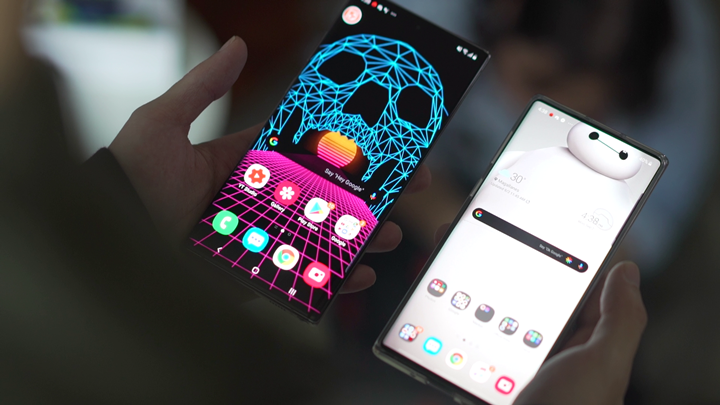
Left: Note 10+, Right: Note 10
To me, the standard Note 10, while it will be enough for bringing in new Note users, it just feels like an S10 with an S-Pen. The Note 10+ however, is what long-time Note fans have been waiting for since the last iteration. After spending almost a month with this hunk of a smartphone, boy do I have a lot to say.
Table of Contents
At 6.8-inches, it’s Samsung’s biggest phone to date. You can call it a phablet, in the most real sense of the word. Though slightly more subtle than in previous years, the screen still curves towards the edges, resulting in slim bezels on the sides. But even the top and bottom bezels remain very thin — with the top one, in particular, being able to achieve this thanks to the updated Infinity-O design, commonly known as the punch-hole.
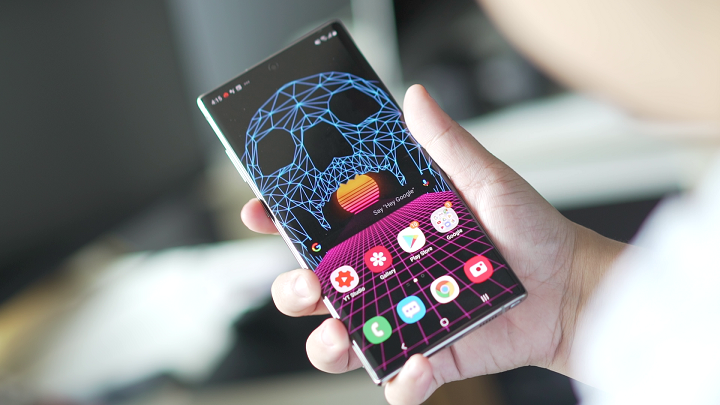
On the subject of the punch-hole, two things are strange to me. One being the center placement, and the second — for the Note 10+, why isn’t it a dual-lens setup like in the S10+? For the former point, I liked the S10 series’ corner placement of the punch-hole because you can ignore it more easily. However, for this center-positioned one, you can still remedy this by using a clever wallpaper, and over time you get used to it anyway. I will discuss the latter point in the camera section of this review.
Moving things over to the back, the tough Corning Gorilla Glass 6 panel curves towards the edges, making it look and feel very fluid. I’m not a big fan of the Aura Glow colorway though, as the literal mirror-finish lends itself to even the smallest form of dirt, smudge, or fingerprint.

The quad rear camera setup on the top left corner of the back is a departure from Samsung’s typical design language of putting the rear camera/s at the upper center. It makes the Note 10 series look similar to almost all other phones on the market, so that’s one signature design point Samsung has decided to give up.
The one that’s been bugging everybody since launch is, of course, the absence of the beloved headphone jack. While the Note 10+ does come with some pretty good AKG USB-C earphones, we believe this is the industry sign wired audio lovers have been dreading. If Samsung says the headphone jack is canceled (in the mainstream), then it might as well be.
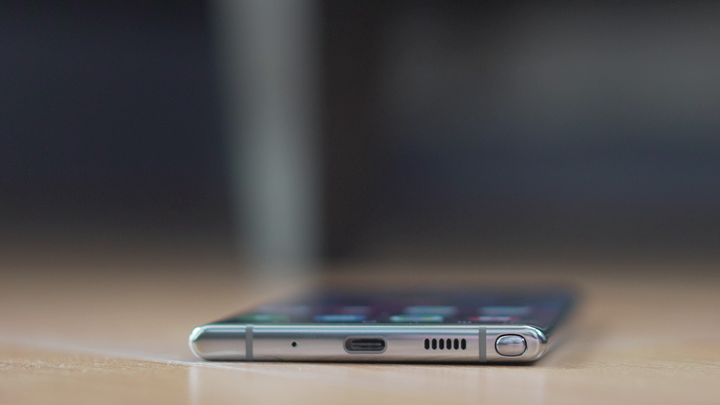
At the bottom though, instead of a headphone jack, we get the USB Type-C port, downward-firing speaker, noise-canceling microphone, and the slot for the S-Pen. Physically, this year’s stylus remains the same as last year’s. Though internally, it now has motion sensors that enable a lot of things software-wise.
Heading to the opposite side, the top, we have the hybrid card tray that can accommodate either two nano-sized SIM cards or one of those plus a microSD card up to 1TB. This small feature is another reason the Note 10+ makes a stronger case for Note-dom compared to the standard one.
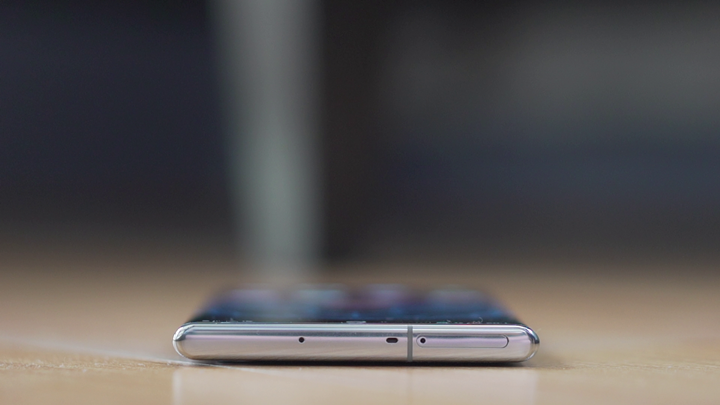
Beside the tray is another noise-canceling microphone, and a small cavity that leads to the speakerphone. I appreciate this subtle design choice because it makes all the difference for audio. Since the top bezel is slim, the speakerphone/earpiece has to be just as thin. It is fine for regular calls, but remember that Samsung flagships have stereo audio. The hole on top allows another pathway for the sound to escape from, making the audio sound louder and clearer.
Due to the flatness of the top and bottom, the device takes on a boxy look which reminds us of older Sony Xperia smartphones. The corners are rounded out just enough such that the phone feels great in hand or your pocket — that is if you have a big enough pocket for this guy!

Rounding off the design, on the left side are the volume rocker and power button. Left-handed users will enjoy the placement the most, but I think most of us can agree that the removal of the Bixby button was a welcome change. I also like having the power and volume on one side. But this boils down to a matter of personal preference.
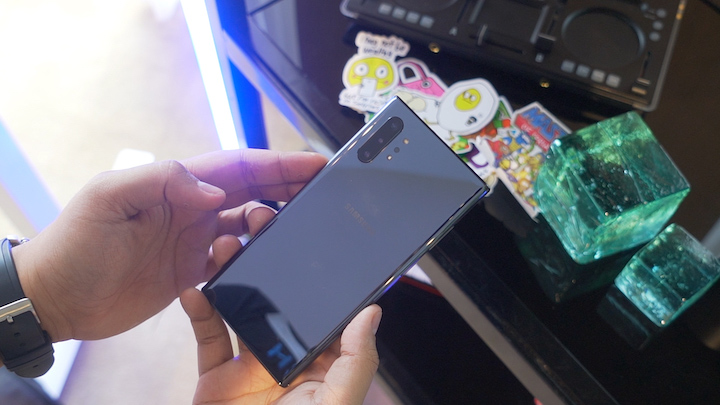
The Note 10+, aside from being the biggest, is also one of Samsung’s prettiest-looking phones to date. The industrial design lends itself a lot to the productivity-focused nature of the line-up, and it has some clever functionality tucked away. I’m also quite impressed that it’s just as thin as the S10+ at just 7.9mm.
The Note 10+ sports a 6.8-inch Dynamic AMOLED Infinity-O display with a maximum resolution of 3040 x 1440, which equates to 498ppi. Out of the box, the resolution is set to 2280 x 1080, but you also have the option of going down to 1520 x 720 if you want to maximize battery life.

Even at FHD+, the screen looks fantastic, thanks to the deep blacks, vibrant colors, and a wide range of brightness. With all these factors at play, you don’t notice that the image isn’t as sharp as WQHD+, but bumping up the resolution makes it all the more pleasant to the eyes.
Just like the S10 series, it has other features that can enhance the experience such as HDR10+, advanced blue light filtering, customizable color temperature, and touch sensitivity control, to name a few.

You need not worry about the punch-hole when viewing wide content either. The 19:9 aspect ratio is usually more than enough to handle anamorphic (2.35:1) format titles on Netflix and other platforms, while still hiding the punch-hole in a little black bar.
As for the audio experience, it does not disappoint. I still prefer front-facing speakers like some device, but this year’s Samsung flagships have convinced me that the downward-firing and earpiece combo can be just as good. The Note 10+’s pair makes for an excellent listening duo to provide an immersive experience. They get loud, such that when you’re in a quiet room, the maximum volume is almost unnecessary. Highs and mids are crystal clear, with a hint of bass from the bottom speaker, and there is decent separation. Turning on the Dolby Atmos mode puts all these aspects into overdrive.
The Note 10+ is the ultimate multimedia device; the best one there is right now. I don’t expect that to change until next year.
Quickly on the included AKG Type-C earphones — they’re one of the best-sounding included earphones I’ve tried. Most of the cable is braided, there are in-line controls, and a variety of different-sized tips are included. Sound quality is also decent but inferior to the Galaxy Buds. The mids are clear, but bass and highs are a little bit lacking. The highs get a little bit more accentuated when you activate Dolby Atmos mode, though.
The Note 10+ provides a wide array of photography options. The rear module consists of a 12MP main wide-angle, a 12MP telephoto, a 16MP ultrawide, and a TOF 3D camera. The primary rear camera has the variable aperture that’s been around since the Galaxy S9. All of them except the TOF camera are equipped with image stabilization, although only the main and telephoto have Dual Pixel PDAF.

For selfies, it has a single 10MP shooter with Dual Pixel PDAF. As with the S10+, I do think it would have been entirely appropriate if the Note 10+ had a secondary front camera. It would have been perfect if it had a wide-angle lens for group selfies, but a depth-sensing camera would have also made for a more feature-packed phone.
Shots from both the front and rear cameras come out great, especially in bright outdoor settings. It’s a joy to shoot with a selection of focal lengths, shots from all the lenses come out looking sharp with a high dynamic range, and colors pop. It seems to me that over the years, Samsung’s post-processing has gotten more aggressive in how it boosts colors, though it does this effectively, especially for skin tones.
Live Focus mode still works as good as ever, providing good subject-background separation, and I always enjoy being able to adjust the blur after the fact. In sub-optimal lighting conditions though, the Note 10+, or any Samsung flagship for that matter, would not be my weapon of choice. Details end up appearing muddy, previously vibrant colors get washed out, and shadows are peppered with noise.

The dedicated Night Mode, however, works great for shots around the city and such, with a right balance of bright and dark spots. The noise gets cleaned up a little bit, highlights don’t get blown out as much, and the shot looks more dynamic.
For video, the Note 10+ can shoot up to UHD 4K (3480 x 2160) for both the front and rear cameras. Since the display has HDR10+ support and there isn’t a lot of content available yet, it’s good that you can at least shoot video in HDR10+.
Just like with the photos, video quality is excellent as long as you’re shooting in well-lit conditions. At 4K, shots come out looking very sharp with beautiful colors, and stabilization is on point. The camera app now also has a built-in video editor where you can do basic things like splice together clips, add text, and add music.
The S-Pen receives new functionality as mentioned earlier. It now has Air Actions that lets you control the camera app through gestures. You can flick up to switch between the front and rear cameras or make a circular motion to zoom in and out.

Aside from the usual set of features like Pro Mode, Panorama, Portrait (Live Focus), Slow Motion, etc., there is a slew of brand new features. Most of the new things we get in terms of the camera in the software.
There’s AR Doodle, which allows you to draw on top of videos, which will then track the motion and match the position in 3D space. It works on faces, but I think the Everywhere mode is even cooler because, with the right conditions, the motion tracking is superb.
For the TOF camera, there’s the 3D Scanner that gives you a full 360-degree 3D model of the object of your choice. The software isn’t perfect yet and takes a combination of practice, the right subject, and good lighting conditions, but it does work. If your 3D model is anthropomorphic enough, like a stuffed animal, for example, the phone can even rig the joints and match the movement to that of a real person.
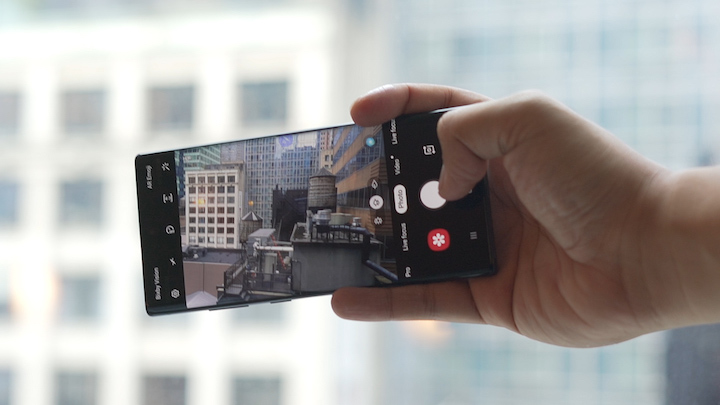
For videos, there are two significant new features. The first being Super Steady Mode, which utilizes the ultra-wide camera to be able to crop and artificially make the optically-stabilized image even more steady. The experience is comparable to using a motorized gimbal, but I recommend only using this with right shooting conditions. The second new video feature is Live Focus Video. It’s Portrait Mode for video with different modes, which granted, has been done before by Huawei, but is an excellent feature for creative expression.
Great camera hardware and software make an excellent combination in any phone, and the Note 10+ has that. Aside from being the ultimate media consumption device, it also makes the right candidate for the ultimate media creation device.
Running the software show is OneUI 1.5 on top of Android 9 Pie. It’s Samsung’s best interface to date with a clean and user-friendly experience. It has features such as Focus Blocks that cleanly presents information, segregated viewing and interaction areas, and our favorite, native Dark/Night Mode. You can navigate via the traditional back-home-recent buttons, but you may opt for gestures instead.

The physical Bixby button may be dead, but software Bixby is alive and well as the default virtual assistant of choice. Other smart features include Device Care for optimizing your device, Game Launcher for a more controlled gaming experience, Samsung Health for fitness tracking, among others.

DeX is also back stronger than ever. Previously, you had to connect your phone to a display and pair a Bluetooth keyboard and mouse. The new DeX allows you to plug your Note 10/Note 10+ into a Windows or Mac computer, which then brings up a window with the DeX virtual desktop, complete with all your apps. It allows you to control your phone with your computer, but also seamlessly drag and drop files between the two.

Samsung’s new partnership with Microsoft also brings the Your Phone app, which lets you send messages from your PC, and wirelessly transfer images between the two. I don’t think it’s a coincidence that those two things sound almost precisely like iMessage and AirDrop.

Almost all of the S-Pen’s new features have to do with the camera. Though the SDK is available to developers, so the motion sensors can be expected to gain more functionality as time goes on. However, on the side of note-taking, we still have the staples like Screen Write, Smart Select, Live Message, Translate, and writing on the Always On Display. What’s new, is you can now have your handwritten notes converted to text and exported directly to Microsoft Word. Convert-to-text is hardly new, but exporting directly to Word is a feature that honestly, should have been here since the beginning. It’s my favorite new S-Pen feature.

Aside from the proprietary apps, pre-installed apps include the standard Google Suite and a few from Microsoft. We don’t mind this, as these are for productivity anyway.
The 256GB variant we have leaves us with 229.12GB of usable storage, which should be plenty enough for all your apps, media, and files. But if it isn’t don’t forget that there’s a microSD slot, and there’s a 1TB storage variant if you’re that space-hungry.
I want to take a moment to highlight another thing before we move on — the Samsung Global Goals app. It’s a new app that allows you to help 17 goals/initiatives set by world leaders, for a better world by the year 2030. You can either donate directly to the goal of your choice or allow the app to show you ads. The ad revenue can then be donated directly to a goal. If you end up buying a Note 10/Note 10+ after reading this review, we highly encourage you to check out this app. Even if you don’t, the app is also available for download for other Android devices, as well as iOS.
Since we get the EMEA variant, the Note 10+ is powered by the new Samsung Exynos 9825, a refresh of the Exynos 9820 present in the S10 series. It was designed to address a few problems found in the Exynos 9820, namely power efficiency and thermals. The SoC is now manufactured using the 7nm EUV process, moving on from the 8nm FinFET process.
It uses two 4th-gen custom cores, two Cortex-A75 cores, four Cortex-A55 cores, plus a Mali G76 MP12 GPU and a dedicated NPU though the clock speed of the Cortex-A75 cores has been bumped up from 2.31GHz to 2.4GHz.

The performance increase in the raw benchmark scores does show a little bit of improvement. However, it’s not that much. But that’s not to say it’s a bad thing — there’s still no doubt that the Exynos 9825 is now Samsung’s most powerful chip to date.
• AnTuTu – 348,080
• 3D Mark SSE – 4,846 (OpenGL ES 3.1), 4,642 (Vulkan)
• PC Mark – 7,881 (Work 2.0)
• Geekbench – 4,371 (Single-Core), 9,999 (Multi-Core), 11,991 (RenderScript)
• AndroBench – 1,476.34 MB/s (Seq. Read), 586.85 MB/s (Seq. Write)
The Note 10+ is truly a workhorse of a device, breezing through any task you throw at it. It’s smooth, fast, and highly responsive. With the hefty 12GB of RAM, multitasking is seamless, and at the highest settings, any game is buttery smooth.
Even the internal storage is faster now, looking at the rear and write speeds of the Note 10+ compared to the S10+. The improved chipset, large RAM capacity, and fast storage truly make it the fastest Samsung flagship.
While the Note 10+ does lack a headphone jack, it still features the other connectivity options you expect a flagship phone to have. It’s got dual nano-SIM support, microSD support up to 1TB, Wi-Fi 6, LTE Cat.20, dual-frequency GNSS, Bluetooth 5.0, NFC, and USB 3.1 Type-C.
For biometric security, the ultrasonic under-display fingerprint scanner and facial recognition make a comeback, and both options are as fast, accurate, and secure as they were on the S10 series.
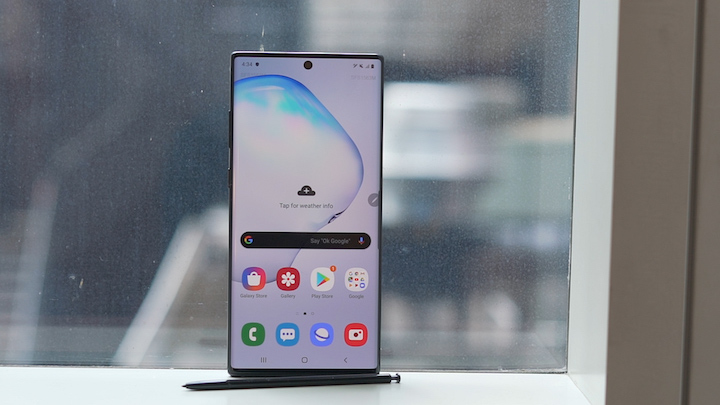
For the battery, the Note 10+ has a 4,300mAh capacity, which is appropriate for a phone of this size and capability. I’ve mostly been using the phone with the FHD+ resolution option, only bumping up to WQHD+ when watching Netflix. Even then, I can usually get a good day and a half without looking for a charge.
In our standard video loop test (1080p MP4 video played on a loop, 50% brightness & volume, airplane mode turned on, headphones plugged in), we got 19 hours and 53 minutes of playback.
For charging, the Note 10+ supports Fast Charging up to 45W, Qi fast wireless charging 15W, and reverse wireless charging from the S10 family makes a comeback. There’s a 25W charger in the box and getting to a full 100% from an empty battery only takes about an hour. That’s very fast considering the huge 4,300mAh capacity.
With its starting price tag of PHP60,990USD 1,039INR 88,106EUR 990CNY 7,569, it can get easy to dismiss this phone as way too overpriced. But, think about it this way — The S10+ starts at PHP55,990USD 954INR 80,883EUR 909CNY 6,948. For just PHP5,000USD 85INR 7,223EUR 81CNY 621, you may be losing an additional front camera and a headphone jack. But almost everything else gets a boost, like the bigger screen, better chipset, more RAM, more storage, better cameras, a bigger battery, and an S-Pen that’s there if you need it.
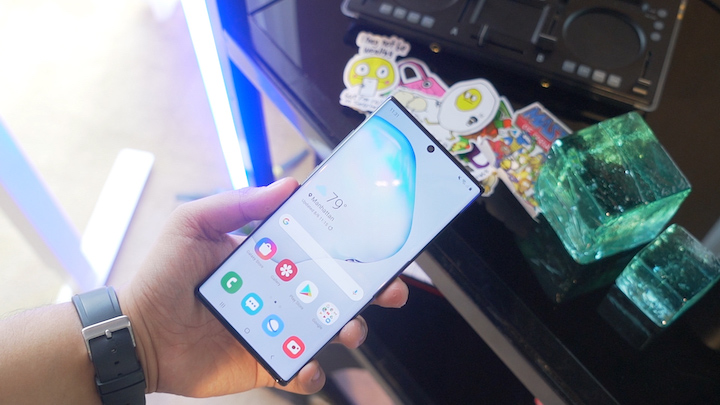
It would be unfair to the Note 10+ though if we base it on how it compares to the S10+. On its own, it does a better job of carrying the “Galaxy Note” name and lineage than its little brother. The Note 10+ is the real Note 10 — and the Note 10 is more like the Note 10 Lite.
Until further notice, this is the ultimate device for productivity, multimedia consumption, content creation, and raw performance — and mind you, all of that is in a very sleek, sexy package.
See local pricing for the Samsung Galaxy Note 10 series below:
What I liked:
• Beautiful design
• Premium build
• Great display
• Great cameras
• Great performance
• Better S-Pen
• Long battery lif
• Fast Wireless Charging
What I didn’t:
• No 3.5mm headphone jack
• Pricey

YugaTech.com is the largest and longest-running technology site in the Philippines. Originally established in October 2002, the site was transformed into a full-fledged technology platform in 2005.
How to transfer, withdraw money from PayPal to GCash
Prices of Starlink satellite in the Philippines
Install Google GBox to Huawei smartphones
Pag-IBIG MP2 online application
How to check PhilHealth contributions online
How to find your SIM card serial number
Globe, PLDT, Converge, Sky: Unli fiber internet plans compared
10 biggest games in the Google Play Store
LTO periodic medical exam for 10-year licenses
Netflix codes to unlock hidden TV shows, movies
Apple, Asus, Cherry Mobile, Huawei, LG, Nokia, Oppo, Samsung, Sony, Vivo, Xiaomi, Lenovo, Infinix Mobile, Pocophone, Honor, iPhone, OnePlus, Tecno, Realme, HTC, Gionee, Kata, IQ00, Redmi, Razer, CloudFone, Motorola, Panasonic, TCL, Wiko
Best Android smartphones between PHP 20,000 - 25,000
Smartphones under PHP 10,000 in the Philippines
Smartphones under PHP 12K Philippines
Best smartphones for kids under PHP 7,000
Smartphones under PHP 15,000 in the Philippines
Best Android smartphones between PHP 15,000 - 20,000
Smartphones under PHP 20,000 in the Philippines
Most affordable 5G phones in the Philippines under PHP 20K
5G smartphones in the Philippines under PHP 16K
Smartphone pricelist Philippines 2024
Smartphone pricelist Philippines 2023
Smartphone pricelist Philippines 2022
Smartphone pricelist Philippines 2021
Smartphone pricelist Philippines 2020
Paul says:
Nah, still overpriced. When Samsung sold the fixed Note 7 as the Note FE, it went as low as 22k brand new. Even the Note 9 is only 39k now, a drop of 16k in a year.
Samsung just went along with Apple’s joyride of inflating prices through the roof.
Raffaelle says:
Sana po mapanalunan ko yung samsung note 10 plus :) for christmas gift nadin po?
Raffaelle says:
Sana po mapanalunan ko yung samsung note 10 plus :) for christmas gift nadin po?
Richard Joash Tan says:
But I do not care. I will buy a fully loaded Note 10 Plus 512 GB model anyway.